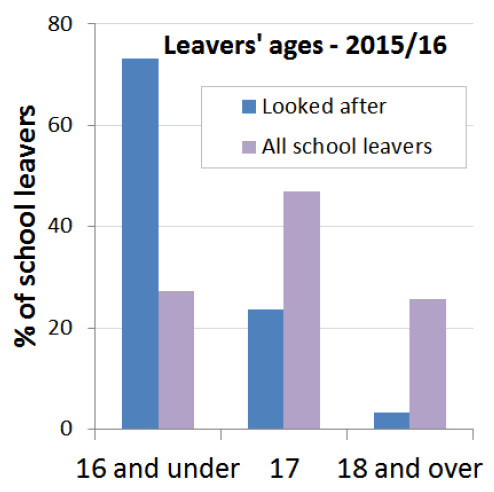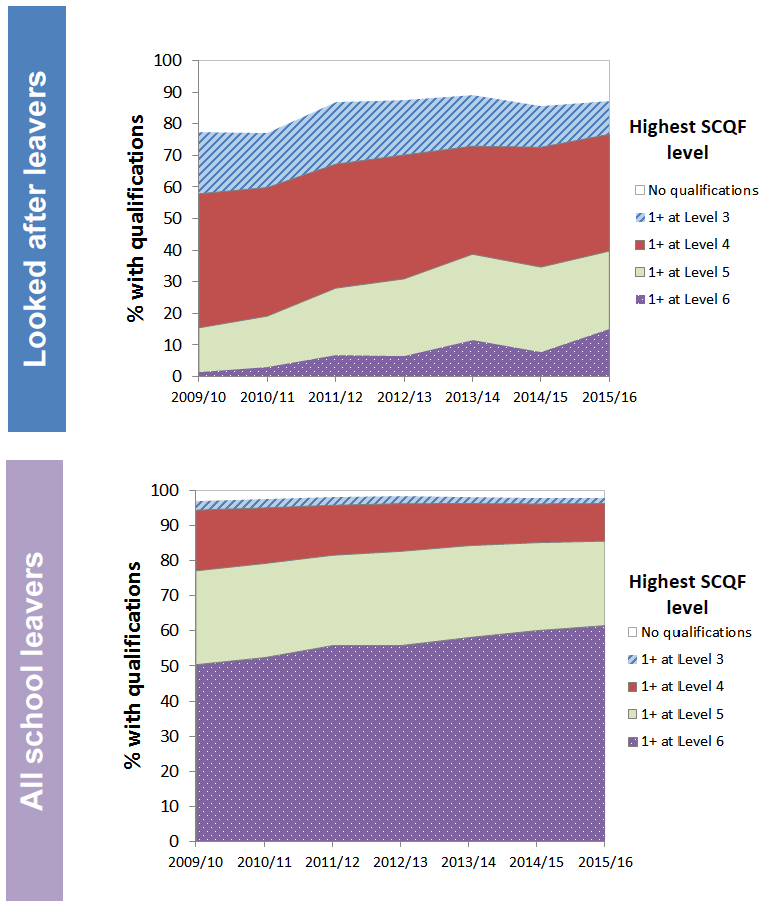Looked after children: education outcomes 2015-2016
Report on the attainment and post-school destinations of looked after children.
This document is part of a collection
Educational attainment
 |
The attainment of looked after school leavers continues to be poorer than for school leavers overall |
 |
Looked after leavers who were in foster placements, and those with fewer placements had higher attainment |
This section presents data on the educational attainment of the 468 young people who were looked after from 1 August 2015 to 31 July 2016 and who left school during 2015/16. All underlying data are available here: http://www.gov.scot/Topics/Statistics/Browse/Children/EducOutcomesLAC
Age of school leavers

Looked after children tend to leave school at younger ages. In 2015/16 almost three quarters (73%) of looked after school leavers were aged 16 and under (i.e. they left school at the earliest point they could) compared to over one quarter (27%) of school leavers more generally. The proportion of leavers who were aged 16 and under has decreased since 2009/10, including among looked after leavers, but discrepancies between looked after leavers and other leavers remain consistent.
Highest level of qualification
Looked after children obtain lower qualification levels on average than all school leavers, which is at least partly explained by the lower school leaving age. In previous years, a system of Tariff Scores was used to measure attainment. However, since 2013/14, leavers have been classified by identifying the highest Scottish Credit and Qualifications Framework ( SCQF) level at which they achieved one or more passes by the time they leave school. This includes SQA attainment at SCQF levels 3 to 7.
Illustration 3 shows the equivalent qualifications over time since Standard Grades ceased to exist in 2013/14 and Intermediate qualifications ceased to exist from August 2015 and both were replaced with the new National qualifications. The current leavers will have taken a range of qualifications, some may have taken the old qualifications, but the majority will have taken the new qualifications. It is not the purpose of this publication to measure the impact of the new system on outcomes for looked after young people.
Illustration 3: Scottish Credit and Qualifications Framework ( SCQF) levels
| Level 3 | Access 3 National 3 Standard Grade (Foundation) |
Level 6 | Higher at A-C |
|---|---|---|---|
| Level 4 | Intermediate 1 at A-C National 4 Standard Grade (General) |
Level 7 | Advanced Higher at A-C |
| Level 5 | Intermediate 1 at A-C National 5 at A-C Standard Grade (Credit) |
Table 1.1: Percentage of all looked after school leavers by their highest level of attainment 2015/16
| Looked after leavers | All school leavers | |
|---|---|---|
| 1 or more qualification at SCQF level 3 or better | 87 | 98 |
| 1 or more qualification at SCQF level 4 or better | 77 | 96 |
| 1 or more qualification at SCQF level 5 or better | 40 | 86 |
| 1 or more qualification at SCQF level 6 or better | 15 | 62 |
| 1 or more qualification at SCQF level 7 | 1 | 19 |
| No qualifications at SCQF level 3 or better | 13 | 2 |
Older data available at http://www.gov.scot/Topics/Statistics/Browse/Children/EducOutcomesLAC
As can be seen in Table 1.1, while the level of qualifications of looked after school leavers shows the least difference to that of all school leavers at the lowest level of qualification (87% of looked after school leavers have at least one SCQF level 3 qualification or better, compared to 98% of all school leavers), the difference increases proportionally at higher levels.
Almost all school leavers (96%) have at least one qualification at level 4 or better (see Illustration 3 above for list of qualifications). This compares to three quarters (77%) of looked after leavers with the same level of qualifications. At the higher levels of qualification, more than three in five of all leavers (62%) have at least one qualification at level 6 or better while three in twenty looked after leavers (15%) had qualifications at this level.
However, while looked after school leavers achieve less highly than school leavers more generally, educational attainment among looked after leavers has improved over the last seven years, narrowing the gap. However, this narrowing hasn't been uniform, and there have been falls in some years and at some levels. Chart 2 shows the highest level of qualification held by looked after leavers and all leavers over time (excluding level 7 for clarity, as numbers are very low among looked after leavers). The proportion of looked after leavers with no qualifications has fallen from 23% in 2009/10 to 13% in 2015/16, although this number has changed little since 2011/12. Over the same period the proportion of looked after leavers with one or more qualification at level 5 or better jumped from 15% to 40%, and those with level 6 qualifications has also reached its highest level at 15%. The ongoing increases in numbers achieving higher-level qualifications is one of the most notable areas of improvement in recent years.
Chart 2: Highest level of attainment of looked after leavers and all school leavers, 2009/10 to 2015/16

Highest level of qualification by type of accommodation
When a young person is looked after, there are various types of residences in which they could be placed. Placements can be at home (where a child is subject to a Supervision Requirement and continues to live in their usual place of residence), foster care, a kinship care placement (where they are placed with friends or relatives) or a residential placement. Table 1.2 presents the attainment of looked after leavers with only one placement in 2015/16 by the type of placement.
Table 1.2: Percentage reaching highest level of attainment of looked after school leavers with one placement for the year, by the accommodation type of that placement 2015/16 (1)
| 1 or more qualification at SCQF level 3 or better | 1 or more qualification at SCQF level 4 or better | 1 or more qualification at SCQF level 5 or better | Total number | |
|---|---|---|---|---|
| In the community | ||||
| At home with parents | 74 | 56 | 11 | 66 |
| With friends/relatives | 92 | 82 | 54 | 90 |
| With foster carers provided by LA | * | 93 | 64 | 110 |
| With foster carers purchased by LA | * | 94 | 55 | 47 |
| In other community (2) | - | - | - | 0 |
| Residential accommodation | ||||
| In local authority home | * | 72 | * | 29 |
| In voluntary home | * | 80 | * | 10 |
| In other residential (3) | * | 57 | * | 14 |
| All looked after | 91 | 80 | 45 | 366 |
(1) Cells containing * represent small numbers that have been suppressed to maintain confidentiality.
(2) Includes with prospective adopters.
(3) Includes in residential school, secure care accommodation or crisis care.
Educational attainment varies across the types of accommodation in which looked after children are placed. Overall, more than eight in ten looked after school leavers achieved at least one qualification at SCQF level 3 or better. Children in foster care provided and purchased by the LA perform well (64 and 55% respectively achieving at level 5 or better). School leavers looked after at home had the lowest overall levels of attainment, with 11% achieving at least one qualification at level 5 or better, compared to 40% for looked after leavers as a whole. It is unclear whether the relative success of those in foster care is because these settings encourage better outcomes, or because the circumstances of the people placed within them are more positive - the reason is potentially a combination of these things.
Highest level of qualification by number of placements
Looked after school leavers who experience more placements in the year tend to have lower levels of qualifications. Table 1.3 shows that four-fifths (80%) of looked after leavers who had just one placement all year achieved one or more qualification at level 4 or better compared to almost two-thirds (64%) of looked after leavers who had 4 or more placements during the year.
This trend is more noticeable at higher levels of qualification. 45% of leavers with one placement reached level 5 or better, whereas less than a quarter of those with more placements achieved so highly. It should be noted that the numbers of young people with larger numbers of placements is small and care should be taken when interpreting these figures.
Table 1.3: Proportion of looked after school leavers achieving qualifications by number of looked after placements they had in 2015/16 (1)
| 1 or more qualification at SCQF level 3 or better | 1 or more qualification at SCQF level 4 or better | 1 or more qualification at SCQF level 5 or better | Total number | |
|---|---|---|---|---|
| 1 placement | 91 | 80 | 45 | 366 |
| 2 placements | 81 | 69 | 26 | 77 |
| 3 placements | 53 | 41 | * | 17 |
| 4 or more placements | * | 63 | 0 | 8 |
| All looked after | 87 | 77 | 40 | 468 |
(1) Cells containing * represent small numbers that have been suppressed to maintain confidentiality.
Cross- UK comparisons
The improvements seen in the proportion of looked after children in Scotland achieving qualifications since 2009/10 mirrors the general trend across the UK. Because of differences in the education systems between Scotland and the rest of the UK (and in the ages at which looked after children's qualifications are measured), it is not possible to directly compare qualification levels of looked after children. See background note 5.3 for further information.
Contact
Email: Ian Volante
Phone: 0300 244 4000 – Central Enquiry Unit
The Scottish Government
St Andrew's House
Regent Road
Edinburgh
EH1 3DG
There is a problem
Thanks for your feedback